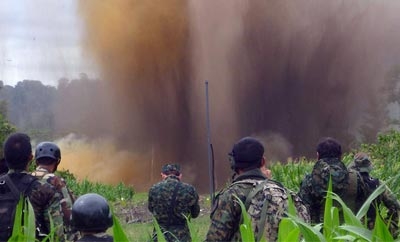There were months of passivity from the authorities while the face of drug trafficking in the region of Peru known as the VRAEM changed: the trains of people carrying drug-laden backpacks became history, and air trafficking once again became the way to export massive shipments. With the constant increase in flights, clandestine airstrips multiplied and the drone of airplanes taking off and flying overhead underlined the boom in drug trafficking and the impunity with which traffickers operated.
This changed in December. On the morning of Tuesday 17, a joint police and navy force launched an offensive against the massive air bridge that is used to move drugs from the Apurimac, Ene and Mantaro River Valleys — the VRAEM — to Bolivia and then on to Brazil.
These forces currently lack the ability to interdict shipments once they are in the air. Instead, they concentrate on targeting the landing strips used by the aircraft. Four specialist teams, each consisting of 30 agents, were deployed by helicopter from a nearby base in Pichari to hit several strips at the same time.
A version of this article originally appeared on the IDL Reporteros website. See original article here.

By midday, the teams had destroyed ten “narco-airstrips” with explosives. In the areas close to the runways, agents found maceration pits and stash points to hide the drugs before they were dispatched. In Paquichari, for example, where two strips were blown up, they found two recently constructed maceration pits.
In actions initiated a day earlier in the nearby zone of Santa Rosa, Navy personnel destroyed 14 maceration pits (although according to the joint communique issued by the Interior Ministry and the Defense Ministry, there were 24 pits destroyed).
The airstrips destroyed during the campaign were found within a relatively small radius, where the Apurimac, Mantaro and Ene rivers meet (see map below). The proliferation of strips in sectors that are flattest and closest to the rivers gives some idea of the intensity of the business of drug trafficking — it shows the areas where drugs converge for shipment and reveals the perception of impunity with which drug traffickers have operated in the past months.
IDL Reporteros collected testimonies from both participants in the operation and residents of the region, who affirmed that the “narco-airstrips” were constructed in part with heavy machinery. The shape of the airstrips that appear in the photos seems to support these affirmations. As there is very little machinery in the region capable of doing this, it should not be difficult to find out who did it, who ordered it and who paid for it.
Considering how close the strips were to each other — with some even intersecting — it appears the drug traffickers did not expect any significant actions to halt their cocaine exports. The operation, it seems, took them by surprise.
After two days, a total of 20 clandestine airstrips were rendered temporarily useless, according to official sources close to the operation.
Although this is the biggest blow to date to aerial drug trafficking from the VRAEM to Bolivia and Brazil, it is essentially a demonstration of will rather than effective interdiction — an even larger number of strips in the Valley have not been touched.
In October, IDL Reporteros reported there were approximately 40 “narco-airstrips” in the VRAEM, although only around 20 were active, each servicing an average of three or four flights a day. Since then, the number of strips and flights has increased.
Taking into account the frequency of daily flights, in planes loaded with 350 kilos of drugs each, conservative estimates indicate that 1.2 tons of cocaine is exported by air from the VRAEM every day — 28.8 tons a month.
SEE ALSO: Peru News and Profiles
Alongside the regular forces deployed during the operation, the government also dispatched special forces used to combat the Shining Path guerrillas. Specialist personnel from the police counter terrorism unit Dircote, and anti-drug unit Dirandro, worked alongside soldiers from the FEC special forces unit. The actions they undertook were quick, intense and above all, unexpected. The impact on the drug traffickers seems to have been confusion and momentary retreat.
Nevertheless, as noted, an important number of clandestine airstrips were not touched.
In addition, it is clear that a strategy of blowing up airstrips is not sustainable in the long term. First, filling up the craters left by the explosives is relatively quick and simple; second, these operations are expensive and ever more risky; and finally, it is easier to build airstrips than it is to render them useless.
Various sources with knowledge of the issue indicate that the Peruvian government will probably now start to quickly organize an aerial interdiction program based on the successes of the one put into practice in the 1990s, which came to an end after a plane carrying US missionaries was accidently shot down in 2001.
The problem is that it is unlikely the United States will provide radar and intelligence support, which was decisive in the past. These days, the United States is not willing to back interdiction efforts that include shooting down aircraft that refuse to land.
It is very likely that in the coming weeks, there will be a discussion between the two countries over the methods, protocols and the limitations of aerial interdiction. It is likely, though not certain, that differences of opinion will remain.
Nevertheless, the Peruvian government has other cards to play. Brazil, for one, has a clear interest in collaborating with Peru to control its airspace, as much of the exported drugs end up in Brazil.
Meanwhile, the 20 airstrips that were dynamited in two days had an immediate impact, and seemed to indicate that the inexplicable period of passivity over tackling Peru’s cocaine air bridge has come to an end.
*A version of this article originally appeared on the IDL Reporteros website. See original article here.

